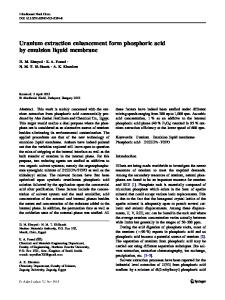Separation of cobalt and tungsten carbide by anodic dissolution of solid alloys in phosphoric acid
- PDF / 275,225 Bytes
- 5 Pages / 612 x 792 pts (letter) Page_size
- 92 Downloads / 322 Views
BRIEF COMMUNICATIONS
SEPARATION OF COBALT AND TUNGSTEN CARBIDE BY ANODIC DISSOLUTION OF SOLID ALLOYS IN PHOSPHORIC ACID V. V. Malyshev and A. I. Hab
UDC 546.05.26-162 + 546.05.78
Alloys of tungsten carbide with cobalt were the first cermet solid alloys used in the industry [1]. To return valuable components of solid alloys to production, it is necessary to develop a procedure of secondary processing of their wastes. Cobalt is separated from tungsten carbide in the process of anodic dissolution in solutions of phosphoric acid used as an electrolyte. By using this procedure, we managed to perform selective separation of the components of solid alloys and obtain commercially valuable tungsten carbide. The susceptibility of tungsten and its carbide to passivation in aqueous solutions determines the specific features of its electrochemical behavior. Method For the investigation of the anodic dissolution of electrodes made of WC–Co alloy, metallic cobalt, and tungsten carbide (W), we used a three-electrode system. A 1.25 M solution of phosphoric acid (H3 PO4) was used as a working electrolyte. As electrodes of solid alloy, we took WC–6% Co (VK-6) fillets prepared according to the standard technology of powder metallurgy [2] at the Kabardino-Balkarian Plant of Diamond Tools (Nalchik). Tungsten-carbide electrodes were produced by hot pressing of tungsten and carbon powders at 2200°C under a pressure of 10 GPa in the laboratory of the Institute for Problems of Strength of the Ukrainian National Academy of Sciences. Cobalt electrodes had the form of plates made of high-purity metal foil. The surface area of the investigated electrodes was equal to 1–2 cm2 . The working electrodes were thoroughly ground and polished by using the methods proposed in [3]. Immediately prior to measurements, polished surfaces were treated with spirit and distilled water. As an auxiliary electrode, we used a platinum plate with an area of 1.0–1.5 cm2 . Electrode potentials were measured in an atmosphere of nitrogen at 18°C relative to a saturated calomel electrode placed outside the cell and connected with it by a salt bridge. Stationary potentiostatic curves were recorded with a PI-50-1 potentiostat by applying direct current. The same equipment and a PDP-4 recorder were used to the record the time dependence of the current. Metallographic investigations were carried out by using a “Neophot-21” electron microscope. The phase compositions of solid specimens and gases were analyzed in a DRON-4.0 X-ray diffractometer and a “Selmikhrom-1” chromatograph, respectively. As a gas carrier, we used argon or helium. The data were processed with the help of an IBM-486 computer. The concentration curves of the distributions of cobalt and tungsten in cross-sectional microsections were obtained with an “MS-46 Cameca” X-ray microanalyzer. The partial currents in the process of dissolution of metals were found by splitting the total recorded current into components according to the results of chemical analysis of the solutions. “Ukraine” Open International Uni
Data Loading...











